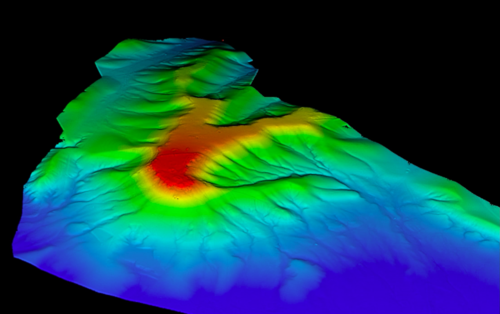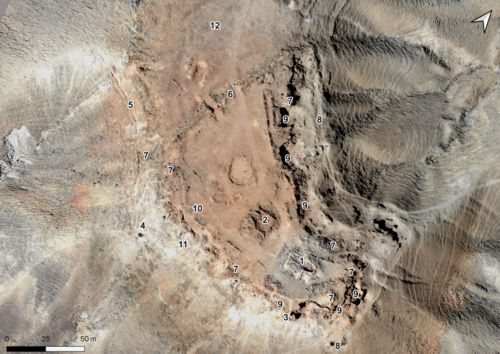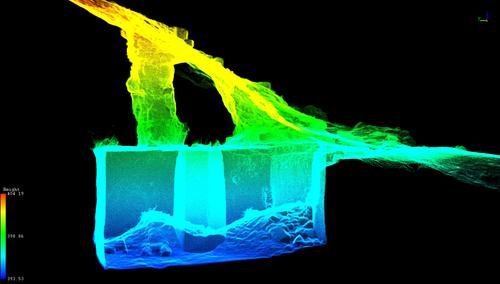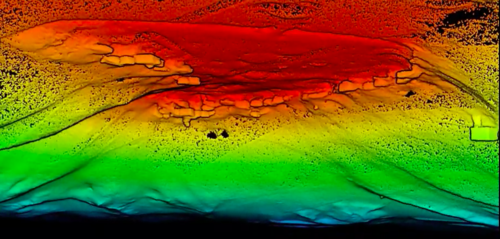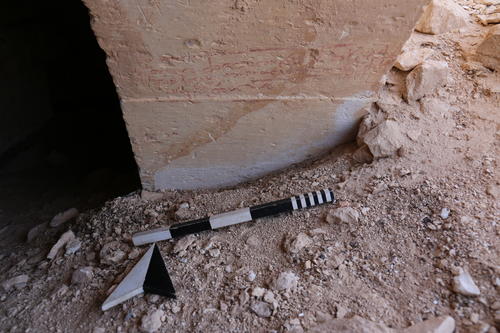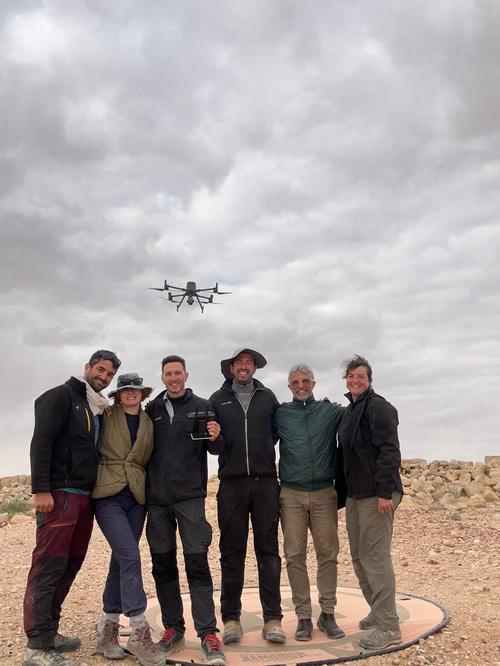Mitzpe Shivta
Fig.1 The LiDAR model shows Mitzpe Shivta as a prominent landmark in the region, surrounded by wadis containing relics of Roman and Late Antique agriculture (Source: Enso)
Fig.2 Prayer niche with a view of the surrounding landscape towards the settlement of Shivta (Source: Sina Lehnig)
Fig.3 Aerial photograph of Mitzpe Shivta with main features (Source: Arne Schröder).
Fig.4 Large rock-cut cistern with two inlets: one via a long channel collecting runoff water along a slope, and another through an opening possibly connected to an overlying structure (Source: Enso)
Fig.5 Rock-cut subterranean spaces in Mitzpe Shivta are clustered around the plateau (Source: Enso)
Fig.6 Greek pilgrim inscriptions on the arched entrances to the rock-cut spaces (Source: Sina Lehnig)
Fig.8 A part of the Mitzpe Shivta team at work with the drone (Source: Ido Shicht)
Monasteries as Repositories of Local Leadership, Agricultural Knowledge and Continuity in the Late Antique and Early Islamic Negev Desert
Project Description
Occupation of Mitzpe Shivta in the northern Negev Desert coincided with times of economic, political and social upheaval and counterculture movements during the mid-6th to 8th centuries CE. This era is marked by the sharp decline of a short-lived Late Antique agricultural florescence of the Negev Desert (4th-6th centuries CE) as a result of global climate change and contracting international markets. External conflicts between the Byzantine Empire and the Sassanids exacerbated the prevailing instability. At the same time, monasticism and pilgrimage tourism flourished in the region.
As part of our project supported by the Gerda Henkel Foundation, we found that Mitzpe Shivta, unlike other Negev settlements, was occupied during this critical period and thrived well into Abbasid times. Its strategic location on a high plateau (Fig.1), as well as its church, chapel (Fig.2), fortification, towers (Fig.3), large cisterns (Fig.4) and numerous rock-cut chambers (Fig.5) adorned with plaster, pilgrim inscriptions and Christian decorations (Fig.6), have led travellers and researchers since the 19th-century to identify the site as an early Christian monastery, a fortress, or a pilgrim hostel. In fact, due to these features, Mitzpe Shivta stands out markedly from other Negev settlements, and the reasons for its establishment remain unclear.
The history of research at Mitzpe Shivta indicates that the site was never fully explored and did not contribute to the plethora of research on the rise and fall of the Negev agricultural society by the end of the Late Antique period. The aim of the project is to 1) gain a deeper understanding of the factors that led to the emergence of a settlement like Mitzpe Shivta alongside a declining urban and economic environment, and to shed light on the 2) background and identity of its inhabitants and their 3) economic model. Moreover, (4) the relationship between Mitzpe Shivta and the larger settlement of Shivta (Fig.7), just 5 km away, should be clarified. As a topographical landmark, and with its fortifications, and sacred elements, Mitzpe Shivta may have served as a kind of “acropolis” for Shivta.
Therefore, especially the religious and defensive elements of the site will be examined. We will explore to what extent the fortification constructions can actually be seen as a response to the local and empire-wide volatile conditions of the mid-6th century CE, and if monasticism and increasing pilgrimage to St. Catherine monastery occupied a newly evolved economic niche in places where commercial agricultural activity declined. It will be clarified, whether Mitzpe Shivta’s inhabitants preserved Late Antique agricultural knowledge and dietary practices or if new foodways were introduced during the Islamic period.
Our project has identified a combined approach of remote sensing, stratigraphic excavations, bio- and geoarchaeological analyses and epigraphy as an appropriate modus operandi to explore the cultural history of this unique site. We aim to clarify previously unresolved questions about the history of the Negev at a time of economic and social stress, for which the well-preserved site of Mitzpe Shivta can be pivotal.
Funding
Funded by the Gerda Henkel Foundation and the Minerva Foundation for Research (Max Planck Society)
Team
Project leaders: Sina Lehnig (Freie Universität Berlin), Guy Bar-Oz (University of Haifa), Gil Gambash (University of Haifa)
Microgeoarchaeology: Ruth Shahack –Gross (University of Haifa), Michelle Gil (University of Haifa)
Epigraphy: Beatrice Pestarino (University of Liverpool)
Lidar, SfM: Ido Shicht (ENSO)
Publications
S. Lehnig, M. Peleg, J. Linstädter, G. Bar-Oz, G. Gambash, Theodor Wiegand in Mitzpe Shivta. Spolia and Heritage Protection along the Ottoman Military Railway, Archäologischer Anzeiger 2, 2025, 1-44.
S. Lehnig, G. Gambash, G. Bar-Oz, From Early Christianity to Early Islam: New Radiocarbon Dates Extend Occupation Period of Mitzpe Shivta in the Negev Desert, Carmel, 2025, 1-19.
G. Gambash, B. Pestarino, S. Lehnig, G. Bar-Oz, Praying for a Place in the Book of the Living. A New Byzantine Inscription from Mitzpe Shivta, Zeitschrift für Papyrologie und Epigraphik, 2023.
S. Lehnig, G. Gambash, G. Bar-Oz, Resurrecting Mitzpe Shivta. Connections between Monasticism and Economy in the Late Antique Negev Desert, Antiquity 369, 2023.
I. Ktalav, Y. Tepper, G. Gambash, S. Lehnig, G. Bar-Oz, Long-distance Trade and Consumption of Mollusks in the Byzantine and Early Islamic Periods in the Negev Desert, Journal of Archaeological Science Reports 37, 2021, 102927.
Masterthesis Michelle Gil on microgeoarchaeological analyses, animal husbandry, agriculture, building material procurement at the site (summa cum laude)
How to understand Mitzpe Shivta? Understanding Mitzpe Shivta within the context of Negev-Sinai monasticism, Rebecca Eisenstadt (PhD thesis, supervised by Gil Gambash and Sina Lehnig)

